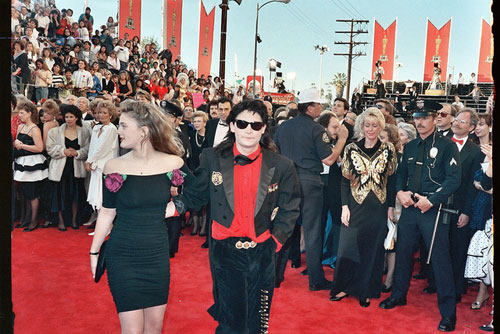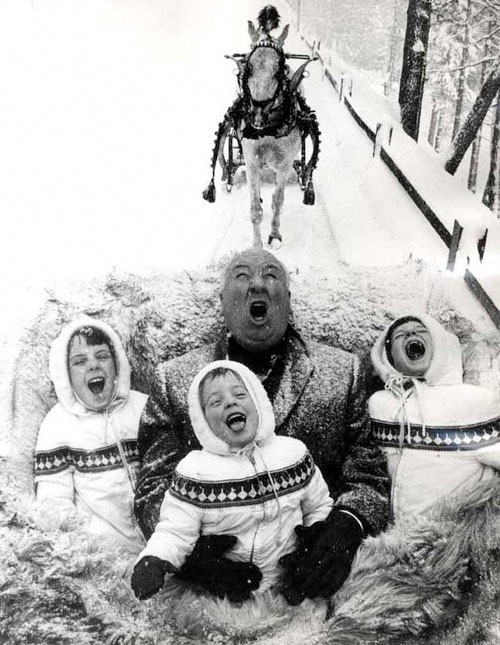kottke.org posts about celebrity
Alan Light got himself invited to the Academy Awards in 1989 with full access privileges…he took along a camera and shot dozens of candid photos of celebrities on the red carpet, at rehersals, and at after-parties. Here are Drew Barrymore and Corey Feldman arriving:

Barrymore, 14, and Feldman, 17, were dating at the time. At this point, Barrymore had been in rehab twice for drugs/alcohol and is two months away from a failed suicide attempt. Light also got photos of Lucille Ball a month before she died, Tom Cruise and Mimi Rogers, Mayim Bialik, Jodie Foster (who won the Best Actress Oscar that year for The Accused) and, my favorite for some reason, River Phoenix.
In this profile of Chris Evans (aka Captain America) for GQ, Edith Zimmerman catches a movie actor on the rise testing the boundaries of his soon-to-be mega-fame.
Since we’re both single and roughly the same age, it was hard for me not to treat our interview as a sort of date. Surprisingly, Chris did the same, asking all about me, my family, my job, my most recent relationship. And from ten minutes into that first interview, when he reached across the table to punctuate a joke by putting his hand on top of mine, Chris kept up frequent hand holding and lower-back touching, palm kissing and knee squeezing. He’s an attractive movie star, no complaints. I also didn’t know how much I was supposed to respond; when I did, it sometimes felt a little like hitting on the bartender or misconstruing the bartender’s professional fliirting for something more. I wanted to think it was genuine, or that part of it was, because I liked him right away.
Is this the part of a celebrity profile where I go into how blue the star’s eyes are? Because they are very blue.
(via @choire)

I found this photo of Alfred Hitchcock with three children here labeled “Alfred Hitchcock and his kids” but since he only had one child and looks older in the photo, I assume those are actually his three granddaughters, Mary, Tere, and Katie.
Anyway, lots of other rarely seen celebrity photos here, including a few fakes — notably the JFK/Monroe one done by Alison Jackson — an unheartthrobby George Clooney as a teen, and Hitler’s baby picture. (via ★genmon)
Great Roseanne Barr piece in New York magazine last week about fame and her shitty network TV experiences.
During the recent and overly publicized breakdown of Charlie Sheen, I was repeatedly contacted by the media and asked to comment, as it was assumed that I know a thing or two about starring on a sitcom, fighting with producers, nasty divorces, public meltdowns, and bombing through a live comedytour. I have, however, never smoked crack or taken too many drugs, unless you count alcohol as a drug (I don’t). But I do know what it’s like to be seized by bipolar thoughts that make one spout wise about Tiger Blood and brag about winning when one is actually losing.
It’s hard to tell whether one is winning or, in fact, losing once one starts to think of oneself as a commodity, or a product, or a character, or a voice for the downtrodden. It’s called losing perspective. Fame’s a bitch. It’s hard to handle and drives you nuts. Yes, it’s true that your sense of entitlement grows exponentially with every perk until it becomes too stupendous a weight to walk around under, but it’s a cutthroat business, show, and without the perks, plain ol’ fame and fortune just ain’t worth the trouble.
From a tweet by Dustin Curtis quoting a Twitter employee:
At any moment, Justin Bieber uses 3% of our infrastructure. Racks of servers are dedicated to him.
When will references to “all my racks at Twitter” make it into pop/rap songs?
After an LA Times interview of George Michael in which the singer talks of his desire step away from the limelight, Frank Sinatra wrote the Times and Michael a letter.
Come on George, Loosen up. Swing, man. Dust off those gossamer wings and fly yourself to the moon of your choice and be grateful to carry the baggage we’ve all had to carry since those lean nights of sleeping on buses and helping the driver unload the instruments.
And no more of that talk about “the tragedy of fame.” The tragedy of fame is when no one shows up and you’re singing to the cleaning lady in some empty joint that hasn’t seen a paying customer since Saint Swithin’s day. And you’re nowhere near that; you’re top dog on the top rung of a tall ladder called Stardom, which in latin means thanks-to-the-fans who were there when it was lonely.
The letter is much better if read in the voice of Phil Hartman’s SNL impersonation of Sinatra. In fact, Hartman did a SNL skit as Sinatra with Dana Carvey as George Michael shortly after this letter was published. Can’t find that anywhere online, but I did find one of my all-time favorite SNL skits: the Sinatra Group.
You don’t scare me. I got chunks of guys like you in my stool.
Razzle Dazzle is a six-part video series on how fame is portrayed in Hollywood films.
Razzle Dazzle is a six-part video essay that looks at how movies have examined the many facets of fame (heroism, infamy, and everything in between) and how they have shaped the audience’s perception of what fame offers. Chapter 1, “The Pitch,” lays out how movies are just one component of an all-consuming media that is constantly shaping the modern image culture. Subsequent chapters look at certain archetypes — the Hero, the Fraud, the Parasite, the Maverick — that have become staples of the media cycle.
Part one and part two are currently available.
I started a bit of stupid fun on Twitter: #webappcelebs. Some of my favorites so far:
Pablo Picasa
Favrd Flav
Eddie Van Hahlo
Bit.ly Houston
daniel craigslist
Paul Reubens on Rails
Keira Writely
Google Lou Reader
Gwyneth Paypaltrow
Sid Del.ico.us (also: Benicio Del.ico.us)
Opera Winfrey
AIM Judy Dench
Wilford Brizzly
Eartha Typekitt
And I can’t find it, but I swear I saw someone do Lucy Hululiu, which seems so much funnier that just Lucy HuLiu for some reason.
Joanne McNeil on The Daily Death:
In the future, a famous person will die every fifteen minutes. Already it’s happening. The ascent of the microcelebrities, the 24 hour news cycle, citizen journalism, and our darkest fantasies all collide on Twitter now. The website’s rhetorical question “What are you doing?” sometimes feels more like “Who died today?”
I wrote about something similar a few years ago in a post called Death in the celebrity age:
Chances are in 15-20 years, someone famous whose work you enjoyed or whom you admired or who had a huge influence on who you are as a person will die each day…and probably even more than one a day. And that’s just you…many other famous people will have died that day who mean something to other people. Will we all just be in a constant state of mourning? Will the NY Times national obituary section swell to 30 pages a day? As members of the human species, we’re used to dealing with the death of people we “know” in amounts in the low hundreds over the course of a lifetime. With higher life expectancies and the increased number of people known to each of us (particularly in the hypernetworked part of the world), how are we going to handle it when several thousand people we know die over the course of our lifetime?
The population pyramid for who the average American knows (or knows of enough to care) probably looks something like this:

That’s a lot of future death.
Update: On Twitter, Kurt Anderson quoted David Kipen:
Baby Boomers have created so many celebrities that, in the future, somebody famous will die every fifteen minutes.
Update: The NY Times has a slightly different take on the recent rash of celebrity death:
This summer could come to be known as the summer when baby boomers began to turn to the obituary pages first, to face not merely their own mortality or ponder their legacies, but to witness the passing of legends who defined them as a tribe, bequeathing through music, culture, news and politics a kind of generational badge that has begun to fray.
I don’t know if you’ll enjoy reading a NY Times profile of the Olsen Twins, but I was oddly fascinated.
Mary-Kate’s contribution to the enterprise is a collector’s knowledge. She has been buying vintage Lanvin and Givenchy, among other classic labels of the mid-20th century, for a number of years. (Unlike Ashley, Mary-Kate continues to act, having played, with a perfect semblance of haze and obfuscation, a born-again Christian drug dealer on the third season of “Weeds.” This year she appeared opposite Ben Kingsley in the film “The Wackness.”) Ashley is the more entrepreneurial, the one who will tell you how much she admires Steve Jobs and Bill Gates.
A list of famous people who have been homeless, most of the “lived in their car” variety. The list includes Hilary Swank, Jim Carrey, Ella Fitzgerald, David Letterman, and William Shatner.
In an excerpt from the soon-to-be-released More Information Than You Require, John Hodgman shares how he became a famous minor television personality and how he deals with all that fame.
As a matter of fact, sometimes now, if I’m feeling tired or a little sad, I’ll go put on my UPS-man outfit and hit the subway. I’ll hope that maybe someone will recognize me. It’s very embarrassing, isn’t it? But most of the time, it doesn’t happen. No matter how crowded it is, no one says anything. They are reading, talking, thinking about where the train is taking them next. They don’t say anything to me at all. And that’s when I sit back, and look at them all, and think to myself: Don’t any of you have a television? What THE FUCK is wrong with you people? I’M SITTING RIGHT HERE!
Some of this is from a bit Hodgman did for an episode of This American Life earlier this year.
Wired writer Sonja Zjawinski commissioned for-hire paparazzo Izaz Rony (previously) to follow her around for the day and take photos.
I leave the coffee shop with Rony trailing unobtrusively. I’m beginning to understand why celebrities go nuts, shave their heads, and bounce in and out of rehab; I would, too, if I had relentless photographers on my tail 24/7. When I stop to peruse a pair of shoes at an outdoor stall, Rony snaps away at me through a rack of dresses, startling a fellow shopper. “Sorry,” I sheepishly explain. “That’s, uh … my photographer.”
I don’t feel like a celebutante hounded by the media anymore; I feel like the lamest lame-o in Phonytown. And I’ve had enough of it. I call off the shoot.
(via fimoculous)
From Coolspotters, a new site that tracks celebrity use of brands and fashion, here’s a list of celebs that use an iPhone, including Heidi Klum, Karl Rove, Paris Hilton, and, er, Steve Jobs. (via mike davidson)
In the late ’90s, pop-culture historian Bill Geerhart had a little too much time on his hands and a surfeit of stamps. So, for his own entertainment, the then-unemployed thirtysomething launched a letter-writing campaign to some of the most powerful and infamous figures in the country, posing as a curious 10-year-old named Billy.
He wrote to Charles Manson, Ted Kacynzski, and Dick Cheney, among others…and they wrote back. Richard Ramirez, aka the Night Stalker, wrote back on his own personalized letterhead. (thx, andrew)
Some advice from Michael J. Fox.
No matter how much fame you have, it’s not something that belongs to you. If I’m famous, that doesn’t belong to me — that belongs to you. If you can’t remember who I am, I’m no longer famous.
And a bunch of other stuff that’s surprisingly candid and good.
The last episode of Ricky Gervais’ Extras has a message concerning celebrity and television:
“The Victorian freak show never went away,” Millman rails in a soliloquy that serves as a climax of the “Extras” final episode and a moment of redemption for the character, whose life and friendships have been corrupted by fame. “Now it’s called ‘Big Brother’ or ‘American Idol,’ where in the preliminary rounds we wheel out the bewildered to be sniggered at by multimillionaires.”
To the networks, he says: “You can’t wash your hands of this. You can’t keep going, ‘Oh, it’s exploitation, but it’s what the public wants.’ No.”
To the audience watching at home, he says: “Shame on you. And shame on me. I’m the worst of all. Cause I’m one of these people that goes, ‘I’m an entertainer, it’s in my blood.’ Yeah, it’s in my blood because a real job’s too hard.”
These half-n-half celebrity face mashups are unsettling. “The right half of a face has to be from one celebrity and the left half from another.” The Bill/Hillary and the Cruise/Holmes ones are especially good.
Early this morning, Paris Hilton was released from jail after serving a 23-day sentence for violating her probation on a prior conviction for reckless driving. Here’s a photo taken soon after her release:

We see photos of celebrities smiling in public all the time, at movie openings, at awards shows, on stage, on TV, on red carpets…anywhere there’s a camera waiting to capture a public image. Hilton in particular is known for smiling in public, chin down and looking up to the right. But the above photo is the first time she’s ever looked genuinely happy, an authentic smile. Never have all those smiling celebrity photos — and the purposes behind them — looked so phony.
Cockney rhyming slang meets celebrity namedropping. “I left my Clare Rayners down the Fatboy Slim so I was late for the Basil Fawlty. The Andy McNab cost me an Ayrton Senna but it didn’t stop me getting the Britney Spears in. Next thing you know it turned into a Gary Player and I was off my Chevy Chase.”
Paul Schmelzer’s project to collect autographs of his (Paul’s) name from famous people. So far, he’s got scrawls from David Sedaris, Yoko Ono, Frank Gehry, and Pat Buchanan, but has been turned down by Mikhail Baryshnikov.
Are you worried about the future glut of obituaries in national newspapers? Because I sure am. Think about it: because of our networked world and mass media, there are so many more nationally known people than there were 30, 40, or 50 years ago. Fifty years ago, to be famous you had to be a politician, a movie star, a sports star, a general/admiral, a writer, a musician, a TV star, or rich. These days, we have many more popular sports, more sports teams, more movies are being made, there are 2-3 orders of magnitude more TV channels and programs, more music, more musical genres, more books are being written, and there’s more rich people. Plus, these days people routinely become famous for appearing in advertising, designing things, being good cooks, yammering away on the internet, etc. etc. A year’s worth of guests on Hollywood Squares…there’s 2300 people right there that probably wouldn’t have been famous in 1953, and that’s just one show.
Frankly, I don’t know how we’re all going to handle this. Chances are in 15-20 years, someone famous whose work you enjoyed or whom you admired or who had a huge influence on who you are as a person will die each day…and probably even more than one a day. And that’s just you…many other famous people will have died that day who mean something to other people. Will we all just be in a constant state of mourning? Will the NY Times national obituary section swell to 30 pages a day? As members of the human species, we’re used to dealing with the death of people we “know” in amounts in the low hundreds over the course of a lifetime. With higher life expectancies and the increased number of people known to each of us (particularly in the hypernetworked part of the world), how are we going to handle it when several thousand people we know die over the course of our lifetime?
Adam Greenfield sights a celebrity hero in New York. “We finished up our meal, we retrieved our bikes, and we rode away, into the ongoing rush and joy of a life given to me in large measure by the unhappy-looking man at the table behind us.”
Man supposedly caught cheating with Cameron Diaz responds to the press coverage on his weblog. “I told my wife, ‘One of the reasons this is so stupid is because you know that if I was hooking up with [Cameron Diaz] you’d have been the first one I high-fived.’”
Newer posts









Stay Connected